Past Winners
Past WinnersTemporary Cardiac Assist
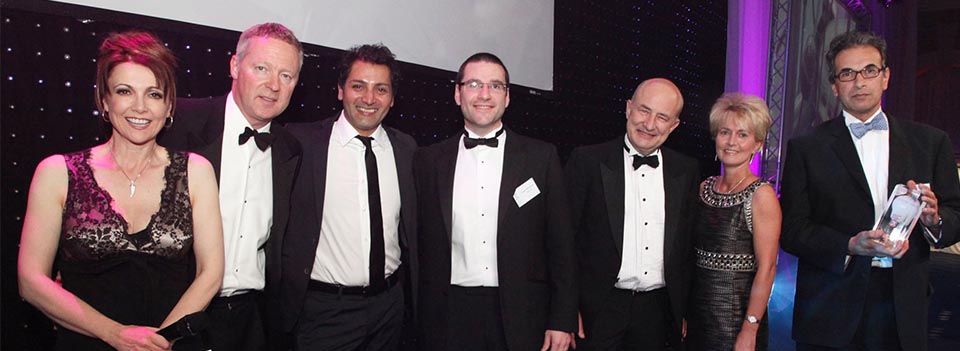
Mr Samer Nashef and Mr Stephen Large Papworth Hospital NHS Foundation Trust
Overall winner of The Cardiovascular Innovation Awards 2011
What is it? This is a medical device used for the treatment of patients following open heart surgery. When a patient is having open heart surgery their heart is put on a bypass machine, which carries out the work of their heart and lungs. After coming off the bypass machine, some patients’ hearts struggle for a short while in returning to normal function and at present these patients may require a very expensive balloon pump to be inserted to assist the heart.
What’s new? This innovation involves a modification to the heart lung machine, a machine to which the patient is already connected. In this new system, once the bypass machine is switched off, if the patient’s heart is struggling then the machine is simply switched back on, in a different mode that listens to the patient’s heart beat and when it is not beating the machine pumps blood backwards to the heart keeping it supplied with vital oxygenated blood all the time. This new machine will remove the need for a proportion of the patients to have to have a balloon pump inserted, which is currently a very invasive and costly procedure and also means that a solution is available at press of a button, unlike current systems which take time to organise.
Who will use it? It will be used by cardiac surgeons. The US Perfusion market is $304m in 2008, although the biggest growth in this area is in India & China.
Video
NOX: Prevention of Ventilator Associated Pneumonia
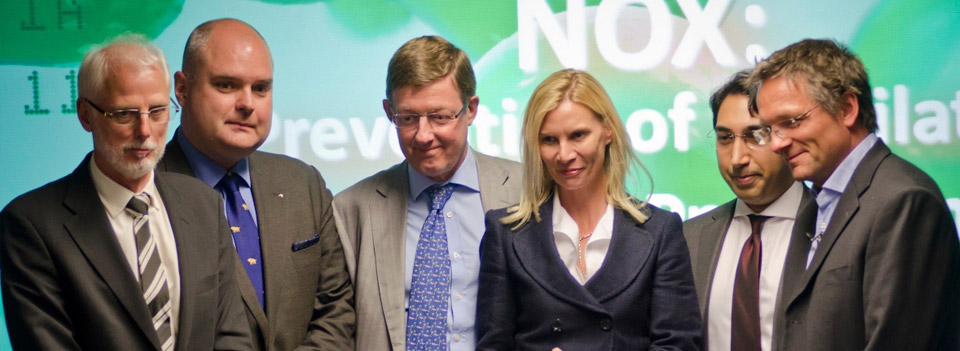
Dr Joanne Stewart, Dr Arthur Tucker, Professor Charles Hinds and Team Queen Mary University of London & Barts and the London NHS Trust
Overall winner of The Respiratory Innovation Awards 2011
What is it? This is a new therapy to prevent pneumonia associated with patients being treated on a ventilator. This innovation is a therapy consisting of a liquid of nitric oxide, a chemical that plays a key role in defence, but whose levels are significantly reduced during illness.
What’s new? The team are the first to look at the restoration of normal physiological levels of these natural defences by delivering a liquid solution into the mouth and stomach of patients whose lungs are being mechanically ventilated. This is in stark contrast with previous work which has looked at the use of Nitric Oxide in the respiratory system, something the team wishes to avoid as it is potentially toxic if it gets into the lungs. All current therapies involve the use of antibiotics which carry a major issue with resistance.
Who will use it? More than 60,000 patients are mechanically ventilated in UK intensive care units annually, with an average stay of five days and a cost of more than £500m. Up to a third of these patients develop pneumonia. The team envisage that their treatment will be administered to all patients being placed on a ventilator to try and prevent them developing pneumonia.
Video
Reduced discomfort dental injections
Dr John Meechan, Mr Chris Lawrence and Mr Philip Harley Newcastle University
Overall winner of The Dental & Oral Health Innovation Awards 2011
What is it? This is a modification of a dental local anaesthetic cartridge that allows a buffer solution to be mixed with the anaesthetic so that it causes less pain to the patient when injected.
What’s new? The patent in this innovation is for a new design of syringe that allows two substances to be kept separate within the syringe until the moment before injection. There is a lot of evidence that buffered injections are less painful, but mixing the two substances at the time of injection is time consuming and costly. Manufacturers have been unable to produce buffered anaesthetics as they require them to be acidic to preserve the activity of adrenaline and to enhance shelf life.
Who will use it? The US market for dental anaesthetic cartridges is worth in excess of $150m. The injection market generally is huge with more than 16 billion injections administered per year globally. The market is dominated by a small number of large players and the team’s strategy will be to initially tackle the dental injection market by licensing the technology to an existing manufacturer.
Video
Limbs Alive

Professor Janet Eyre and Mrs Janice Pearse Royal Victoria Infirmary and Newcastle University
Overall winner of The NHS Innovation Award 2011
What is it? This is a novel technology solution to rehabilitate patients after a stroke. If a stroke blood clot to the brain) damages the part of the brain that control movements, patients are often left with weakness down one side of the body. Therapy after a stroke is important but there are not enough therapists to meet demand and the statistics show that less than a fifth of patients regain independence after a stroke. The Limbs Alive system allows patients to work hard on their rehabilitation under the close review of a therapist.
What’s new? The Limbs Alive system is a combination of NHS expertise and the latest state-of-the-art video games in an integrated package to rehabilitate patients after a stroke. Using Cloud server technology it means patients can take their therapy home, and be closer to their family whilst still getting the benefit of NHS therapy.
Who will use it? More than 150,000 people have a stroke in the UK each year occupying around 25% of hospital beds. Stroke has a greater disability impact than any other chronic disease and costs the economy in excess of £6Bn. It is envisaged that hospitals will initiate therapy using Limbs Alive and patients will continue therapy in their homes using consumer consoles and their bespoke accessories.
Video
HapTEL
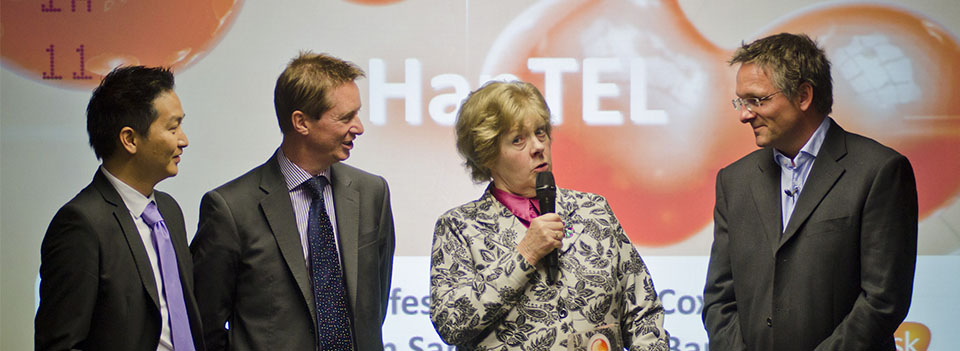
Professor Margaret Cox, Dr Jonathan San Diego, Dr Barry Quinn and Team King's College London
Overall winner of The Best Educational Innovation Award 2011
What is it? This is a new virtual reality dental school to teach the next generation of dentists. This system uses 3D screens, a head tracking device to allow views to reflect what would actually be seen in real life and a foot pedal to control the speed and settings of the dental drill.
What’s new? Although there are competitive systems on the market the HapTEL team believe their system will beat them on performance as well as cost as its unique software platform allows their haptic unit costing £200 to outperform the advanced haptic systems used by competitors, costing in excess of £15,000. The overall unit will sell for £10,000 as compared to £30,000 for the nearest competitor.
Who will use it? There are nine dental schools in the UK and 67 across North America. There are more than 150 countries across the world who provide dental education and with more than two million dentists world over that shall require revalidation, the opportunity for training and educational companies is significant.
Video
Pneumacare
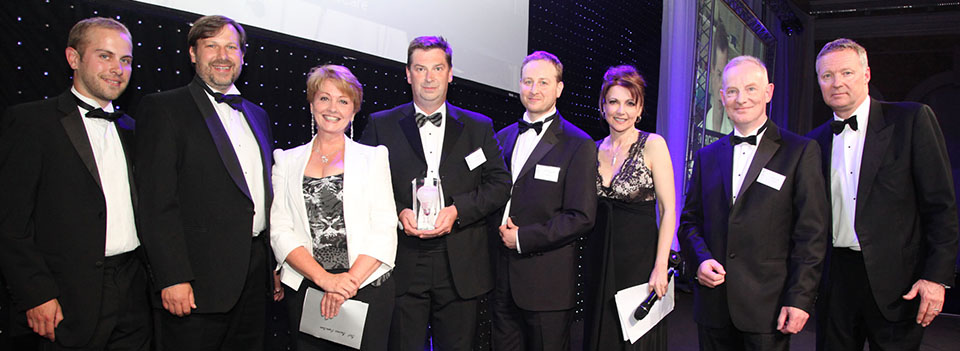
Dr Richard Iles, Dr Ward Hills, and Dr Bill Mason PneumaCare Limited, Cambridge
Overall winner of The Best Business Proposition Innovation Award 2011
What is it? PneumaCare’s product, the PneumaScan™, enables clinicians to assess respiratory function in a whole series of new ways using 3D imaging technology, similar to that used in the entertainment industry. It can tell you how you breathe as well as how well you breathe.
What’s new? Its main novelty is that it is totally non invasive and uses Structured Light Plethysmography (SLP) imaging technology to observe chest wall movements and calculate the volume changes over time. PneumaScan™ also offers new information that existing clinical systems are unable to provide.
Who will use it? Lung disease results in more than 24 million visits to their general practitioner in the UK and is a major challenge. Chronic obstructive airways disease is the fourth biggest killer in Europe with more than 250,000 deaths per year. There are around 30 million people in Europe suffering from asthma. PneumaCare’s first product targets a world-wide addressable market of $357m.The company will have a range of products for both the specialist, generalist and consumer markets.
Video
Cystic Fibrosis Gene Therapy
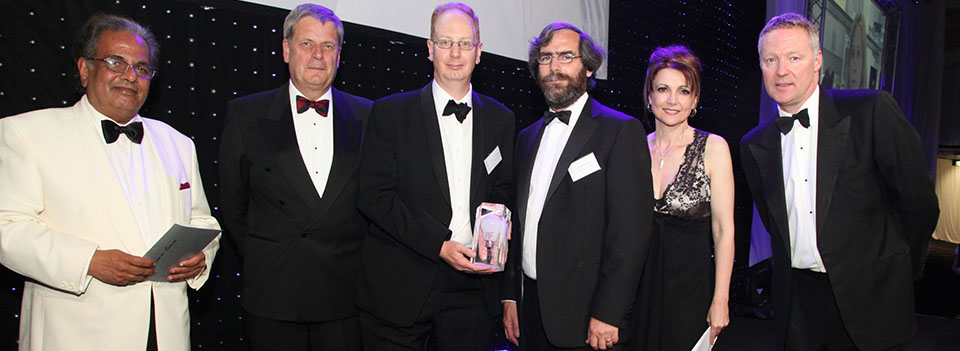
Professor Eric Alton, Professor David Porteous and Dr Stephen Hyde Imperial College, London, University of Edinburgh and University of Oxford
Overall winner of The Translational Research Innovation Award 2011
What is it? This will be a new medical treatment for cystic fibrosis, a disease which clogs up the lungs and digestive tract with thickened secretions causing difficulty breathing and digestion of food, with progressive disability and often early death.
What’s new? The innovation is a novel ‘friendly’ virus that delivers a normal version of the faulty cystic fibrosis gene into the lungs of patients. One dose generates large amounts of the normal protein; an effect sustained for at least two years in animal models, and can be given repeatedly for life-long therapy.
Who will use it? Cystic Fibrosis affects more than 70,000 people worldwide. Only half of those with the disease are expected to live past their mid 30‘s. In the UK alone, more than two million people carry the faulty gene that causes Cystic Fibrosis. The cost of care for a patient varies between £20,000 to £100,000 per year with existing treatments.
Video
BASICS
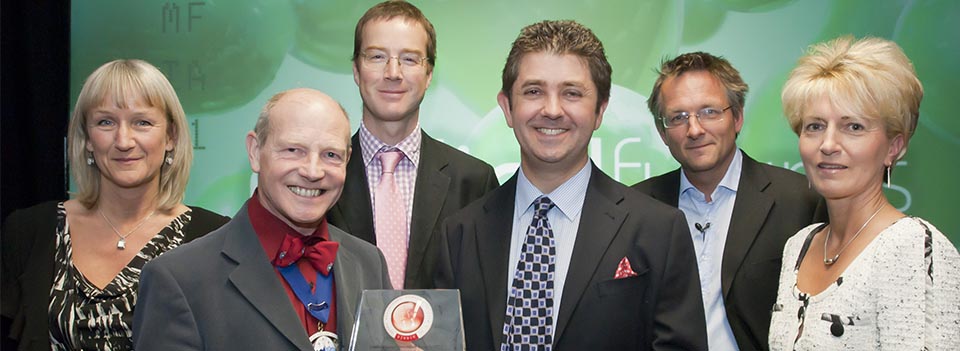
Dr Andrew Weeks, Dr Andrew Gallagher & Dr David Hutchon Liverpool Women's Hospital, University of Liverpool, and Memorial Hospital, Darlington.
OBest Innovation in Service Redesign in the Cardiovascular Innovation Awards
What is it? The Bedside Assessment, Stabilisation and Initial Cardio respiratory Support (BASICS) Trolley is a novel redesign of a newborn resuscitation trolley to take place at the mother's bedside, unlike the current devices which are usually placed in a corner of the room, meaning that the baby has to be taken away from mum and carried over the remote trolley.
What’s new? The-state-of-the-art BASICS trolley can be manoeuvred alongside the bed for a normal delivery, as well as next to a caesarean section or assisted forceps delivery. This means that the baby can remain close to the mum at a time when she most wants them to be within sight. In addition, it means that the baby's umbilical cord can be left intact, ideal for doctors who believe delayed cord clamping offers benefits to babies, especially those that are weak or premature.
Who will use it? There are 700,000 live births in England and Wales each year and more than 4m in the USA. Approximately 10% of these babies need some form of resuscitation at the time of their birth and the team would like to see the BASICS trolley become the de facto standard in delivery rooms around the world.
iDENTifi

Professor Susan Higham, Dr Phil Smith, Dr Elbert de Josselin de Jong and Team University of Liverpool and Inspektor Research Systems
Best Innovation in Patient Engagement in the Dental & Oral Health Innovation Awards
What is it? This is a digital camera system to be used in a dental practice to take close up images of the patient's teeth. The images are relayed wirelessly to a handheld tablet device to provide immediate information to patients and dentists.
What’s new? The iDENTifi system also uses a patent protected fluorescent lighting system and bespoke software that enables visualisation of very early dental caries and dental plaque that is normally invisible to the eye. The system also forms an electronic patient record to allow longitudinal comparisons of the health of the teeth and provides a new system for preventive dental management.
Who will use it? A percentage of the two million dentists worldwide who wish to be at the forefront of technology and innovation, in particular those dentists that wish to empower their patients to proactively look after their oral health and evaluate their preventive dental strategies.
LifeMap
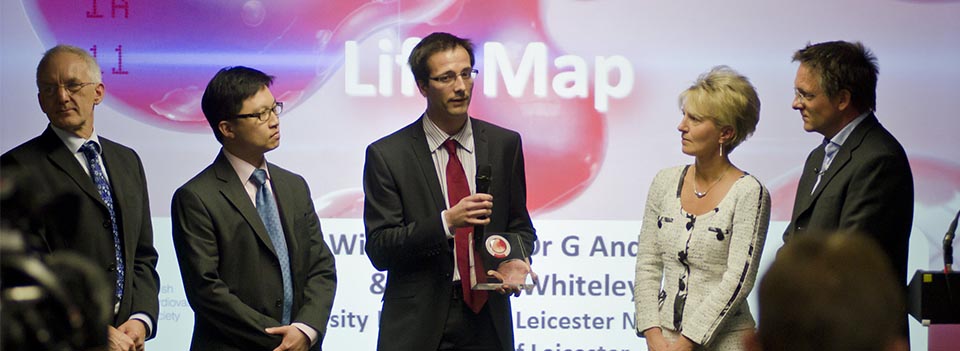
Dr Will Nicolson, Dr G. Andre Ng, Dr Geoff Whiteley, Dr Gerry McCann, and Dr Fernando Schlindwein University Hospitals of Leicester NHS Trust and University of Leicester
Best Innovation in Diagnostics in the Cardiovascular Innovation Awards
What is it? LifeMap is a technology solution to predict patients at risk of sudden cardiac death. Every six minutes someone has a cardiac arrest and some of these patients, whose heart rhythm is unstable, require an implantable cardioverter defibrillator (ICD) at a cost of £20,000, but predicting which patients would benefit from an ICD is at present not possible.
What’s new? LifeMap uses a bespoke computer algorithms to assess a property of the heart muscle known as restitution. It uses a non invasive test to assess the normal and abnormal areas of the heart to create an electrical instability map, something that previously required invasive techniques to achieve.
Who will use it? Worldwide three million people die annually of sudden cardiac death (SCD). Implantable ICDs are effective at preventing these deaths and more than 250,000 ICDs are implanted worldwide each year although there is currently no way each method to determine which patients are at risk of SCD. It is predicted that the LifeMap system will be used on every patient at risk of SCD.
Preventing Cavities the Smart way
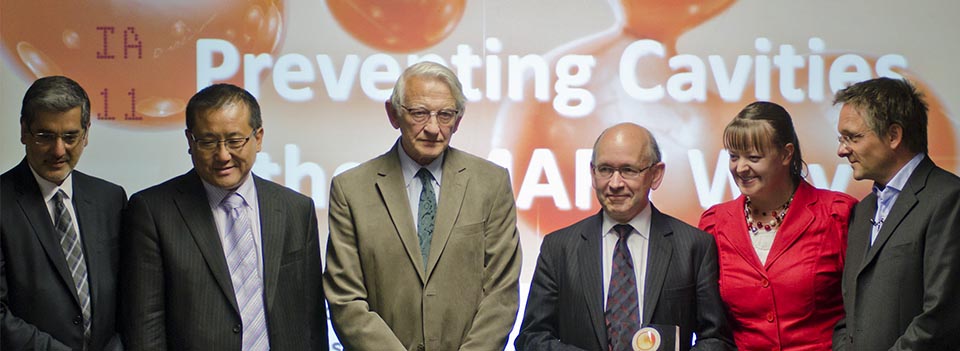
Professor Charles Kelly, Professor Thomas Lehner, Professor Julian Ma and Professor Raman Bedi, Kings College London and St George's Hospital, University of London
Best Translational Research Innovation in the Dental & Oral Health Innovation Awards
What is it? The innovation is a topical gel placed around the teeth to prevent infection with the bacterium (Streptococcus mutans), the main cause of dental caries. The compound is a synthetic peptide (p1025) that mimics the site of attachment of the bacteria but has no effect on other healthy microorganisms in the mouth.
What’s new? AThis is the first pharmaceutical product specifically targeted against the main bacterial cause of dental caries. Built on a novel patent protected molecule, first reported in the Journal, Nature Biotechnology by the lead innovator, it has now gone through preclinical and three human safety & efficacy trials including a Phase I study.
Who will use it? Dental caries is the most common disease in humans affecting 90% of people and can destroy teeth and gums. Chief Dental Officers around the world have declared elimination of early childhood caries as the main priority for dentistry in the 21st century. The team envisages a dental gel as their first product, followed by a toothpaste as the second generation of product, a market worth in excess of $9 billion.
Polaris
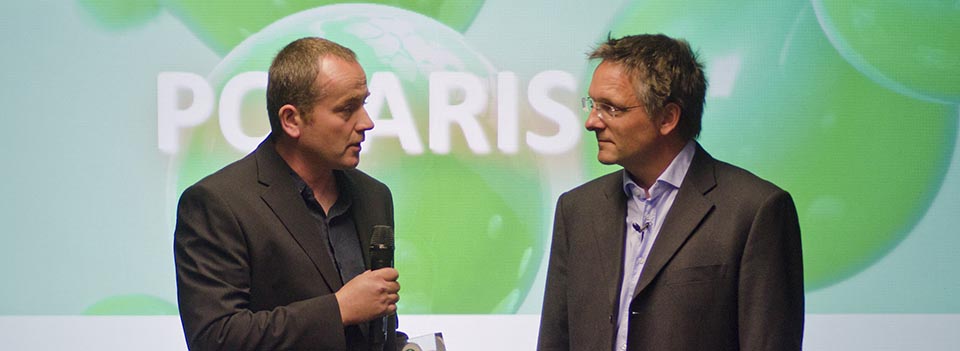
Professor Jim Wild University of Sheffield
Best Translational Research Innovation in the Respiratory Innovation Awards
What is it? This is a novel MRI that uses inhaled inert gases to produce very high resolution images of the lungs. The gases include helium and xenon whose signal is boosted by a special technique called “hyperpolarisation” using the team’s custom built equipment.
What’s new? The group has the only MHRA (regulatory) licence for polarised gas manufacture for human lung imaging. Although there are lots of other imaging modalities available most focus on lung structure and carry the risks of ionizing radiation. In contrast POLARIS has developed techniques to offer a wealth of information on both lung structure and function. In some cases it is so sensitive that it can pick up disease before spirometry.
Who will use it? The technology has significant utility as a research tool for pharmaceutical companies in evaluating therapies with lung imaging biomarkers. A clinical service is also being developed to assist respiratory physicians to pick up early disease and also help manage complex patients suffering from asthma, obstructive airways disease, and cystic fibrosis. At present that service is only available locally but the team is keen to widen their presence nationally and internationally.
Angiogenesis-regulating Peptides
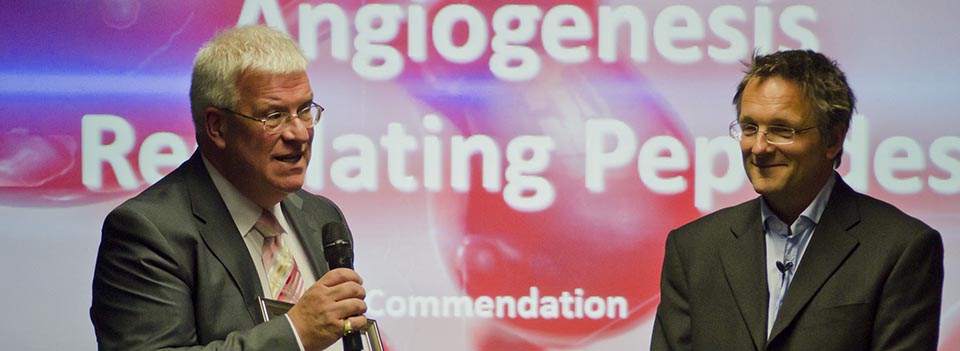
Professor Chris Shaw, Professor Brian Walker, and Dr Tianbao Chen Queen's University Belfast
Commendation in the Cardiovascular Innovation Awards
This patent protected innovation is a series of proteins discovered from frog skin that have the potential to manipulate blood vessel growth and become highly-effective tools to treat cancers and assist in wound healing.
Synthetic Peptides

Professor Nikolaos Donos, Mr Harsh Amin and Professor Irwin Olsen UCL Eastman Dental Institute, London
Commendation in the Dental & Oral Health Innovation Awards
This innovation involves two novel synthetic proteins that can be used for the treatment and regeneration of bone, blood vessels and nerves by inducing the patient’s own stem cells.
Inverseon

Professor Richard Bond and Dr Heather Giles University of Houston, USA
Commendation in the Respiratory Innovation Awards
Inverseon is looking to commercialise the use of beta blockers to treat respiratory disease. This is counter-intuitive as up until recently beta-blockers were contraindicated in this area, however the company have discovered that in chronic use the effect is the opposite and they are now set to take their therapies into clinical trials in chronic airways disease as well as other consumer markets.

